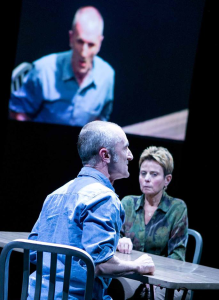
The Anacostia Playhouse is currently showing its newest play, “Frozen,” a suspenseful and high-stakes drama that is nothing like the identically titled Disney film phenomenon. Written by Bryony Lavery, the play debuted in 1998 and moved to Broadway in 2004, after which it received a nomination for a Tony Award for Best Play. This entrancing play revolves around the human condition, an exploration of what it is that we all possess in common, even when we feel as though we are worlds away from those around us.
“Frozen” tells the gripping story of the disappearance and murder of a 10-year-old girl. However, the story is told non-traditionally, through the separate interactions that the girl’s mother, Nancy Shirley (Adele Robey), and killer, Ralph Wantage (Frank Bliss), have with their psychiatrist, Dr. Gottmundsdottir (Jo Sullvan).
This makes Dr. Gottmundsdottir the play’s focal point in that she symbolically bridges the gap of sin that exists between Nancy and Ralph. It is also extremely important that she is a psychiatrist, indicating that the one thing that can connect a transgressor and his victim lies somewhere in the human psyche — in our unique humanity.
Gottmundsdottir is also an expert on serial killers, which is the primary reason she is seeing Ralph — he is one of her case studies. In several scenes, the doctor is portrayed as though she is giving a speech at a conference, in which she projects her recorded conversations with Ralph onto the wall. Intriguingly, the projection is a live feed of Ralph, who is sitting at a table on the other side of the stage. This projection stays on the wall throughout much of the work, as Gottmundsdottir approaches Ralph several times.
Eventually, as the play progresses, she switches seats with Ralph, and she is the only one in the projector’s frame. Now, she has been put under the lens. Gottmundsdottir points out that entering the mind of a serial killer, as she must do so often, takes a toll. She calls the serial killer mind a frozen “Artic sea,” so she is an Arctic explorer. Of course, she explains that, sometimes, when you stay out in the cold for too long, you may begin to freeze. This exploration of what effects the study of the human mind may have on an individual is interesting — Gottmundsdottir becomes attached to her subjects, as she believes that their problem is primarily clinical. Thus, blaming them is difficult for her — she protects them as though their transgressions are only “crimes of illness.” As the cliche dictates, the psychiatrist Gottmundsdottir struggles to cope with her own personal problems in an emotionally stable fashion.
On the other hand, Nancy has struggled for years with the loss of her daughter. She wishes to move past this difficult point in her life. For her, “Frozen” is an extremely powerful play about learning to forgive, learning to accept all humanity and moving on — even amid some of the greatest tragedy.
Gottmundsdottir’s study of the serial-killer brain calls some important things into question for the audience. For one, Gottmundsdottir’s arguments about the specific physical differences between the brain of a killer and a normal one are worth noting. Regardless of the scientific accuracy of her statements, the play is encouraging audiences to consider whether it is possible for someone to be so socially unaware and so lacking in a moral compass without possessing some physical abnormality that enables serial killing.
All three of the actors are rather impressive in their performances, accentuating their very distinct characters while simultaneously making it clear that each of them is dealing with and trying to understand his or her own emotions.
The Anacostia Playhouse makes for a very unique and cozy viewing experience, as the stage is centered in the middle of the room at ground level, surrounded on both sides by incrementally tiered rows of seats. This means that actors have to account for both sides of the room — naturally giving a very different angle of view, and thus perspective, of the play for every viewer.
Not only is the work of high quality, but this is also a great opportunity to cross the bridge and support the arts east of the river. “Frozen” is an extremely well-written, thought-provoking work. Paired with the cozy atmosphere created by the Anacostia Playhouse, this is a very worthwhile performance to see.
“Frozen” will run through March 1, 2015.


















